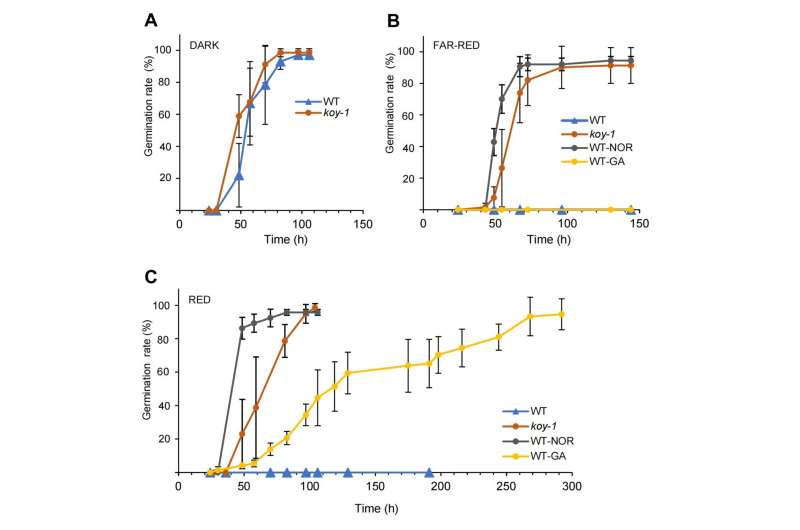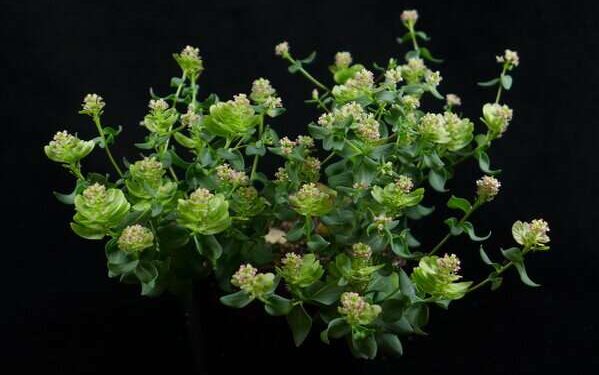Seed germination depends on light in many plants. But not always: Aethionema arabicum, a plant adapted to challenging environmental conditions, does it its own way. Here, the phytochromes, the receptors for red and far-red light, play an unexpected role in seed germination and time this process to the optimal season.
These findings, now published in Plant Physiology, are a compelling example of the evolutionary rewiring of signaling modules that help plants adapt to their habitats. The study was led by researchers at the Gregor Mendel Institute of Molecular Plant Biology (GMI) of the Austrian Academy of Sciences.
While some plant seeds require light to germinate, other seeds are insensitive to or even inhibited by light. Most insights into light’s role during seed germination stem from studies using the model organism Arabidopsis thaliana, where light is required to initiate germination.
In contrast, light is a strong inhibitor of germination in other plants, but the molecular basis of this effect has remained largely unknown. A team of researchers, led by Dr. Zsuzsanna Mérai at the Gregor Mendel Institute (GMI), now used the plant Aethionema arabicum (Brassicaceae) to investigate the molecular mechanism of light-inhibited seed germination.
Aethionema arabicum originates from open and dry habitats where seed germination on the surface during bright, long, and hot days would reduce the chances of seedling survival. Light inhibition of germination is interpreted as a trait to restrict germination to cooler seasons or to seeds located underground.
In their study, Mérai and her colleagues demonstrated that phytochromes, the light receptors for red and far-red wavelengths, play a dual role in the response to light in Aethionema; they can stimulate but also inhibit germination. By measuring the light intensity and duration through phytochromes, the seeds acquire information about the day length and by that, about the season.

A Cypriot variant helps in understanding light inhibition
Mérai and her colleagues use seeds of one Aethionema variant originating from Cyprus (CYP) that do not germinate upon exposure to white light. In its natural habitat, the CYP variant only germinates in early spring when days are relatively short, and temperatures are cool. This allows the plant to complete its life cycle before the dry summer season.
Mérai sought to investigate the mechanism of light inhibition in Aethionema CYP by creating a collection of mutagenized seeds which they screened for mutants that could germinate also in white light, in contrast to the original line. Now, the researchers characterized one mutant at the molecular level.
They called it “koy-1,” after Koyash, the god of the sun in Turkic mythology. They demonstrated that its mutation affected HEME OXYGENASE 1, a key gene required for the biosynthesis of chromophores, the light-detecting molecules of phytochromes. This mutation limits the amount of the chromophore protein and is responsible for the altered light responsiveness of koy-1.
The dual role of phytochromes enables environmental adaptation
The koy-1 mutant allowed Mérai and her colleagues to uncover further mechanistic details. “By varying light intensity, wavelength, and duration, we were able to dissect complex light response patterns linked to phytochromes in Aethionema,” says Mérai.”The low residual amount of functional phytochromes in koy-1 allowed us to unravel a surprising dual role in Aethionema seed germination.”
Their experiments demonstrated that high light intensity and duration strongly inhibited germination, whereas short exposure favored germination. These two opposite responses to light result from different proportions between two key hormones: the germination-inhibitory abscisic acid (ABA) versus the germination-inducing gibberellic acid (GA).
“We already knew that light exposure in Arabidopsis resulted in high GA and low ABA levels. Now, we also know that Aethionema CYP responds similarly under very limited light. However, with increasing irradiance, the hormone levels go literally upside down, resulting in germination inhibition,” says Mérai. “The opposite responses to light intensity and duration have a genetic basis and are an adaptation to the plants’ natural environment, allowing Aethionema CYP to germinate in early spring, but not later.”
Evolution works with rewiring modules
By unraveling that the same molecular players could mediate diametrically opposed effects, the team documents how evolution may have “rewired” existing modules to respond adequately to environmental requirements. With such combinatorial variations, documented in multiple organisms, evolution can attain “quick” changes without the need for new players to evolve from scratch.
“Our findings pave the way for a better understanding of molecular processes in nature and biodiversity by studying non-model organisms and non-crop plants. The scientific knowledge gained from Arabidopsis is essential, but not always representative of all plants. Here, we demonstrate that we could even uncover completely opposite molecular mechanisms in nature,” concludes Mérai, whose work establishes Aethionema as a new model for studying the effects of light on seed germination.








